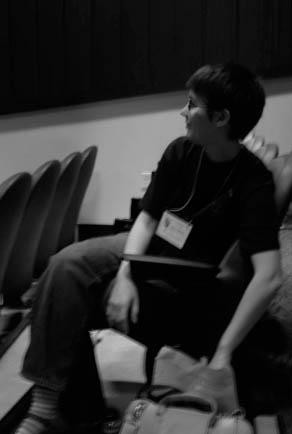Sarah Hamsher
PhD Student
« Return to Home Page «« Return to Lab Members
 |
Sarah HamsherPhD Student My love of algae began as a sophomore at Juniata College where I did independent research projects with Dr. Todd Gustafson and Dr. Doug Glazier. After graduation I had a variety of jobs including a park ranger position at Raystown Lake, an internship with The Nature Conservancy studying ‘butterflies on the rifle range’ at Ft. Indiantown Gap, and finally a permanent position at The Nature Conservancy PA Science Office (now a branch of Western PA Conservancy) assisting other staff with terrestrial invertebrate fieldwork and data management. After a few years, I was ready to return to school to study diatoms as indicators of water quality with Dr. Morgan Vis at Ohio University. To learn diatom identification I attended 'diatom camp' at Iowa Lakeside Laboratory. After completing my Masters degree I went on to work for the USDA, the Lancaster Ohio drinking water plant, and The Academy of Natural Sciences of Philadelphia in the Phycology Section. It was at the Academy through the tutelage of Dr. Marina Potapova and Dr. Eduardo Morales that my fascination with diatom taxonomy blossomed. |
I first met Dr. Saunders at the Northeast Algal Symposium in Poughkeepsie, NY. I was looking for a supervisor interested in allowing me to focus on using molecular techniques to further investigate diatom taxonomy and he was willing to expand his lab to incorporate the wonderful world of unicellular algae. My PhD work is focused on using a short piece of DNA (DNA barcoding) to identify diatom species. The 'classic' DNA barcode (a 650 bp region of the COI-5P of the mitochondrial region) does not display universality (amplify or sequence easily using a single primer pair). The next step was determining the best alternative barcode marker for this unique group of algae. Towards these ends, we are collaborated with Drs. Katharine Evans, David Mann, and Aloise Poulíčková. Sellaphora isolates were used to determine each marker’s ability to discriminate among sister pairs of species and culture collection material was utilized to further explore the ease of developing universal primers, ease of amplification, and resolving power of each marker. This is the resulting publication: Hamsher, SE, Evans, KM, Mann, DG, Poulíčková, A, and Saunders, GW. 2011. Barcoding diatoms: Exploring alternatives to COI-5P. Protist. 162(3): 405-422. Now that we have determined the best alternative markers for DNA barcoding, we are using these markers to identify marine tube-forming diatoms that can found in abundance as macroscopic colonies along the rocky Canadian intertidal, emphasizing the most abundant species, Berkeleya rutilans. We are also collaborating with DFO in St. Andrews on a large scale floristic survey of the planktonic diatoms of the Bay of Fundy. We have cultured >300 single cells/colonies from ~100 species and will be comparing the diversity found using molecular methods to a traditional taxonomic approach. During my PhD at UNB, I am the voluntary webmaster for a number of websites including: the Saunders Lab (since 2007), the Biology Graduate Student Society (2008-2010), and the North American Diatom Symposium (since 2008). Managing these websites has taught me how to organize an effective website and how to maintain a website for a diversity of users. Being a webmaster has also allowed me to volunteer for these organizations. I also co-coordinated the Biology Department Seminar Series (2009-2010). This involved inviting speakers, arranging for their travel, managing the budget, and setting up the room before the seminars. It has allowed me to interact with many professors and professionals outside of my field of study. |
|